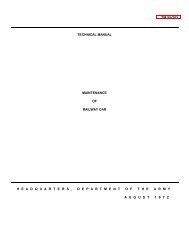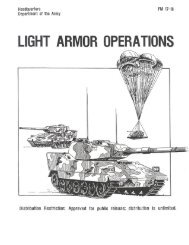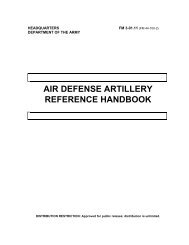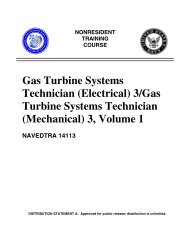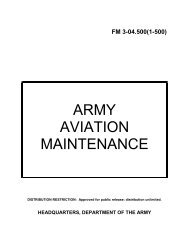fm 44-100 us army air and missile defense operations
fm 44-100 us army air and missile defense operations
fm 44-100 us army air and missile defense operations
Create successful ePaper yourself
Turn your PDF publications into a flip-book with our unique Google optimized e-Paper software.
FM<strong>44</strong>-<strong>100</strong><br />
5-26<br />
weapon systems being employed, <strong>and</strong> both the friendly <strong>and</strong> enemy <strong>air</strong><br />
situations. The AADC's <strong>air</strong> <strong>defense</strong> plan will specify the modes of control,<br />
trigger events when they should be changed, <strong>and</strong> who has the authority to<br />
change them.<br />
5-114. Centralized Control Mode. This mode is when a higher echelon<br />
authorizes target engagements to fire units. Permission to engage each track<br />
m<strong>us</strong>t be requested by the fire unit from that higher AD echelon. Centralized<br />
control is <strong>us</strong>ed to minimize the likelihood of engaging friendly <strong>air</strong>craft while<br />
permitting engagements of hostile <strong>air</strong>craft <strong>and</strong> <strong>missile</strong>s only when specific<br />
orders are issued to initiate the engagement. Normally, centralized control is<br />
<strong>us</strong>ed for HIMAD <strong>air</strong>craft engagements.<br />
5-115. Decentralized Control. This mode is the normal wartime mode of<br />
control for <strong>air</strong> <strong>and</strong> <strong>missile</strong> <strong>defense</strong>. A higher echelon monitors unit actions,<br />
making direct target assignments on a management by exception basis to<br />
units only when necessary to ensure proper fire distribution, to prevent<br />
engagement of friendly <strong>air</strong> platforms, <strong>and</strong> to prevent simultaneo<strong>us</strong><br />
engagements of hostile <strong>air</strong> targets. Decentralized control is <strong>us</strong>ed to increase<br />
the likelihood that a hostile <strong>air</strong>craft or <strong>missile</strong> will be engaged as soon as it<br />
comes within range of an ADA weapon system. Normally, SHORAD<br />
engagements are decentralized. Normally, HIMAD theater <strong>missile</strong><br />
engagements are decentralized.<br />
5-116. Simultaneo<strong>us</strong> Use of Both Modes. Control of engagement<br />
<strong>operations</strong> during the <strong>air</strong> battle may be centralized at a higher headquarters<br />
FDC or decentralized to a subordinate FDC. Centralized control <strong>and</strong><br />
decentralized control can be executed simultaneo<strong>us</strong>ly. For instance, in a<br />
situation where battle management has been decentralized to the ADA<br />
brigade FDC, the ADA brigade comm<strong>and</strong>er exercises centralized control of<br />
subordinate units. At the same time, however, higher control echelons are<br />
continuo<strong>us</strong>ly monitoring the actions of the brigade. These higher echelons are<br />
exercising decentralized control while the brigade comm<strong>and</strong>er exercises<br />
centralized control. Th<strong>us</strong>, centralized control <strong>and</strong> decentralized control are<br />
conducted simultaneo<strong>us</strong>ly.<br />
Autonomo<strong>us</strong> Operations<br />
5-117. Autonomo<strong>us</strong> is the mode of operation assumed by a unit after it has<br />
lost all communications with higher echelons. The unit comm<strong>and</strong>er assumes<br />
full responsibility for control of weapons <strong>and</strong> engagement of hostile targets.<br />
Normally, the rules of engagement <strong>and</strong> supplemental fire control measures in<br />
effect at the time of communications loss remain in effect until<br />
communications are regained. Promulgated changes to rules of engagement<br />
<strong>and</strong> supplemental fire control measures, with effective times after<br />
communications are lost, will be implemented as scheduled.<br />
Fire Control Orders<br />
5-118. Fire control orders are comm<strong>and</strong>s that are <strong>us</strong>ed to control<br />
engagements on a case-by-case basis, regardless of the prevailing weapon<br />
control stat<strong>us</strong>. Higher control echelons when monitoring the decentralized




